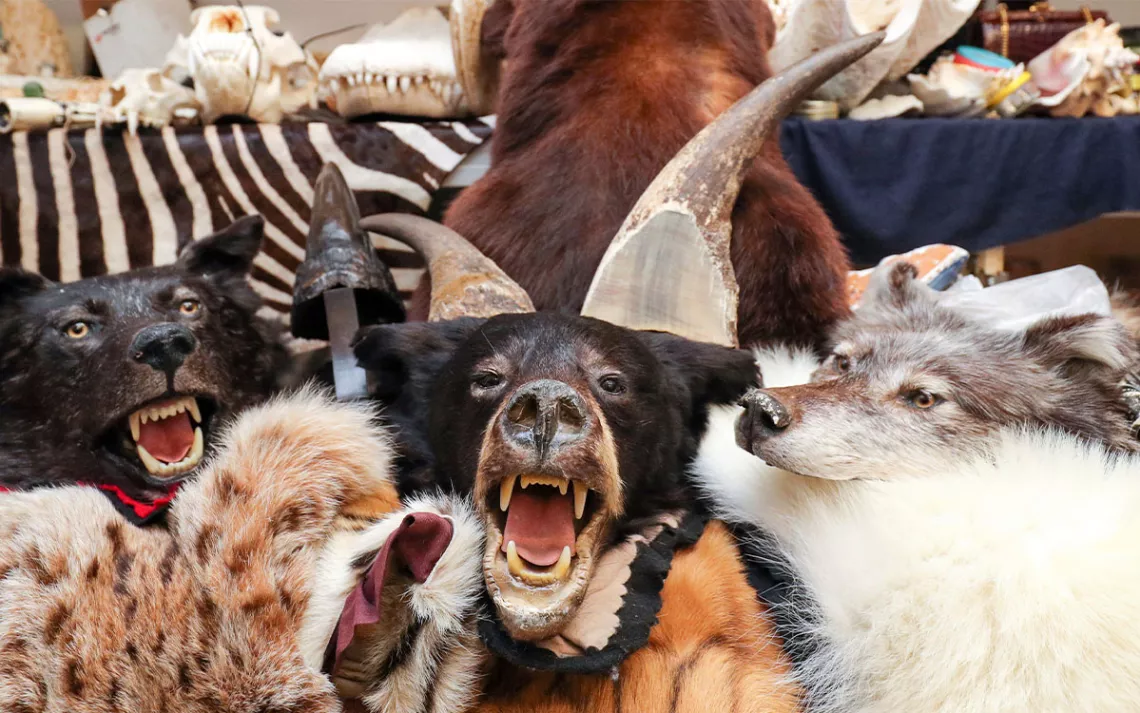The Biggest Predator of All Time: Us
New research confirms that humans push many species to extinction

Seized artifacts, including ivory, animal hides, and other items related to the illegal trade of wildlife, at London's Heathrow Airport. | Photo by Andrew Matthews/Pool via AP
It was once a signature experience at carnival sideshows to see the "deadliest creature on Earth." Visitors to the exhibit would be invited to open a door, revealing … a mirror! Cue surprised laughter: The deadliest animal isn't a venomous snake, a shark, or a grizzly bear, but a human being. I.e., you.
A recent paper published in Communications Biology illustrates just how true that is.
Humans collect, slaughter, or entrap almost 15,000 vertebrate species out of close to 47,000 over six classes, according to the findings of the new report. Of these, our predation threatens 39 percent. Our activities push around 13 percent of all species to the brink of extinction. For mammals alone, 36 percent face extinction because of us. Those facts only apply to present trends. They do not account for our destructive footprint throughout history and prehistory, including many iconic extinctions that we caused, such as that of the passenger pigeon.
The researchers—from Canada, the United States, the UK, and Brazil—relied on the International Union for the Conservation of Nature (IUCN) Red List database, a compilation of globally at-risk species, for the bulk of their findings. They were able to calculate the extent of our impact on other vertebrates, from axolotls to zebra sharks.
One conclusion that surprised researchers was how many of the 15,000—around half—do not end up in the human food chain. Each year, an alarmingly high number of animals supply the multibillion-dollar global wild-pet trade or are killed for trophies and traditional medicines. All of these practices end up "turning animals into 'things,'" Chris Darimont, of the University of Victoria in British Columbia, said via email.
Although animals fated to become companions or zoo attractions are, obviously, not deliberately killed, lifting them from their biological communities results in a kind of de facto death (even if they manage to survive their ordeals). As such, this large-scale extraction factors into the calculation of total global losses.
The paper concentrates on classes of vertebrates containing more than 100 species: ray-finned fishes, birds, mammals, reptiles, amphibians, and cartilaginous fishes (e.g., sharks). "Our estimate of humanity's predatory niche is likely conservative," they state.
How did we come to occupy such a large predatory niche compared to other species with similar dietary needs? "Humans evolved as collaborative group hunters, using advanced cognition, social cooperation, and sophisticated tools to bring down prey much large than us," said Boris Worm, professor of biology at Dalhousie University in Nova Scotia, via email. "We simply got better and better at it and expanded our reach via trade and globalization all around the planet and to a very large number of species we take for our own benefit."
Yet we are very different from other top predators, both qualitatively and quantitatively. Our tools extend or compensate for what the body can or cannot do—just as they help tool-wielding animals. But ours are light-years ahead of a chimpanzee's termite-twiddling twig or nut-cracking rock. Millennia after our ancestors ingeniously grabbed similarly simple items from their surroundings, we have such things as radar-assisted driftnets and high-powered rifles in our toolboxes. In addition to being excellent killing machines, they distance us (literally and figuratively) from our targets so we can safely choose the most impressive male mammals for trophies and the biggest fish for market. Other predators typically target the weakest of a herd—because they have no other choice.
Most of the meat we eat now comes from industrialized farming (itself a source of biodiversity loss, through habitat destruction, water pollution, "pest" control, and so on). Ironically, our heavy reliance on livestock and fish farms does not take much pressure off wild populations. "If anything, food from agriculture and aquaculture allows us to be a better predator," Darimont observed. "It subsidizes us. [This is] in contrast to other predators who overexploit prey and then fall in their numbers; we can just move on to more prey, not yet overexploited."
Our wide niche was a huge reason we became a force to be reckoned with, long ago. "Being a generalist allows our species to thrive in and adapt to many different environments," Worm noted. "This is part of our ecological success. Some other species, such as orca whales or wolves are similarly flexible, and this allows them to occupy a large range as well. Maybe it is no coincidence that both orcas and wolves are also fast-learning, social group hunters."
Removing animals in significant numbers affects much more than their own species. Increasing scarcity affects the species they eat, or are eaten by, as well as the ecosystem functions they all perform such as habitat modification or pollination. The total loss of a keystone species, defined as one whose functions pretty much hold the ecosystem together (e.g., beavers), can be devastating. "Preserving [these species] is a necessity for ensuring that ecosystems will remain functional and resilient," Worm said. "Wild species are the building blocks [of] our planet's life support system, and as such [are] indispensable."
Darimont hopes that their paper will contrast subsistence use by First Peoples with the predominant mode of massive-scale animal exploitation (largely profit-driven) that their study brings to light. "Indigenous peoples, by and large, sustainably exploited prey—until their life ways were interrupted by colonization and industrialized processes relating to predation," he said. "As these societies take back management authority, things might improve."
So there's some hope. The loss of biodiversity is one global problem whose probable solution could be staring us right in the face.
 The Magazine of The Sierra Club
The Magazine of The Sierra Club



